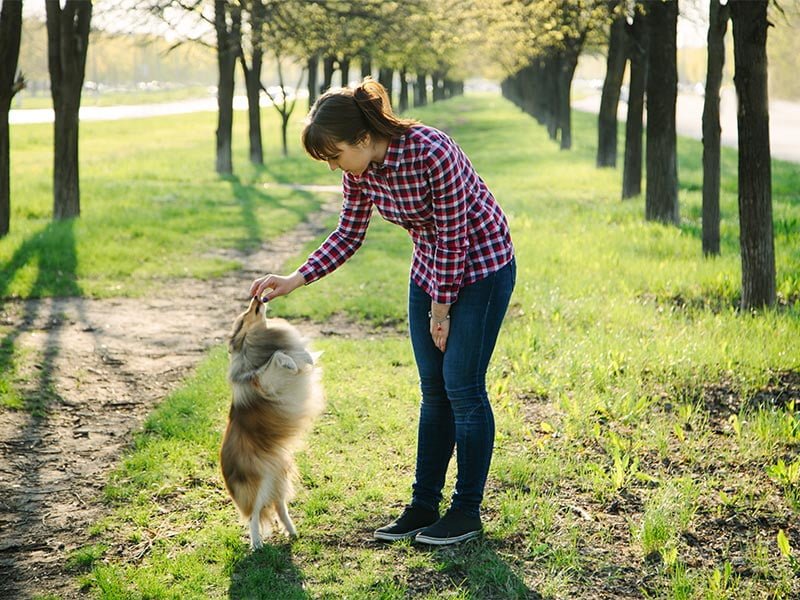There’s a lot of information out there about how to train a dog. You can teach your pet just about anything, using a variety of methods, but there are plenty of mistakes owners make when training their canine companions. These missteps are super common and can have a big impact on whether or not your efforts are successful. To avoid frustration on both ends of the leash, we’ve compiled some universal dog-training mistakes you should do your best to sidestep.
1. Command nagging
One of the biggest problems is command nagging. Command nagging is when your dog doesn’t respond to a cue, so you keep repeating it. This often happens with the word “come.” You say it; your dog doesn’t obey, so you keep saying it. Pretty soon, your dog doesn’t pay attention until you’ve said the word five or six times. By repeating the cue, you’ve taught your pet that he doesn’t have to respond right away — and your cue is now “come, come, come.” It’s imperative to say the cue just once. If your dog is distracted, and you don’t think he’s listening, it’s better not to say it at all. Instead, see if you can get his attention first. This will help you avoid command nagging and train your dog to respond to a single cue every time.
2. Poisoning of cues
Poisoning of cues is another trap that many first-time trainers fall into. This is when you accidentally associate a cue or behavior with something your dog views negatively, so he stops responding. For example, you’ve finally taught your dog “come,” but now, you use it to summon him for a bath — something he hates. You call him, he comes, and you proceed to bathe him. The next day, you ask your dog to come, and he hesitates. Maybe he doesn’t return at all. If there’s something your dog really dislikes, avoid using cues in relation to that activity when you first start training. Once that cue has been reinforced, you might be able to get away with it, but not when he’s learning the commands.
3. Failing to practice in-between classes
Failing to practice in-between training classes is also a big mistake owners make. Practice makes perfect — we all know this — and it definitely applies to dog training. If you attend a class once a week, that’s not enough time to create a well-behaved dog. Make sure you practice every day, but for brief stretches. Dogs have the mentality of a human toddler, and just like toddlers, their attention spans can be short. For most pups, you’ll have better success with 5-to-10-minute sessions.
4. Useless repetition
Another no-no in dog training: Doing the same thing over and over, but expecting a different result. If you keep trying the same method of training, but your dog isn’t picking up on the cue — STOP! Evaluate your pet’s responses, and come up with a new plan.
5. Working when you’re frustrated
Finally, don’t train when you’re in a bad mood. Our patience tends to wear thin when we’re grumpy, and we’re more likely to get mad at our dog for not getting things perfect on the first try. If you had a bad day at work, play fetch with your dog or spend some time snuggling. That’s therapeutic for both of you!
There are many nuances to dog training, but by avoiding these common pitfalls, you’re setting your dog up for success — which will only make the process go faster. That deserves a few happy tail wags!
Recent Pet Posts
Blog Categories
Product categories
- Accessories (7)
- Chicken & Veggie Wraps (8)
- Grillers Jerky Tenders (4)
- Jerky Treats (10)
- Made in the USA (9)
- Non-Rawhide Treats (28)
- Beggar Bone (11)
- Bully Sticks (4)
- Butcher Bone (4)
- Cod Skin Fish Treats (3)
- Pork Skin Twists (2)
- Pressed Rawhide Bones & Rolls (16)
- Bones & Rolls (6)
- Pressed Rawhide Bulk (6)
- Twist Sticks (4)
- Savory Munchies (13)
- Supreme Bones & Rolls (48)
- American Rawhide Bulk (16)
- Rawhide Bones (14)
- Rawhide Chips (6)
- Rawhide Rolls & Sticks (12)
- Uncategorized (8)



1 Comment. Leave new
Probably the most useful and best information I have read in a long time!